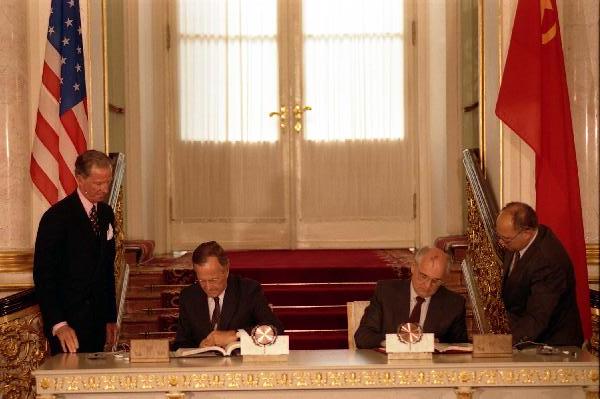On July 31, 1991, the final point in the cold war was put. In the Vladimir Hall of the Grand Kremlin Palace, Soviet President Mikhail Gorbachev and US President George Bush signed the first treaty requiring the US and the USSR/Russia to reduce strategic nuclear weapons. Thus, under the terms of START-1, both sides had to reduce their nuclear arsenals to 6,000 warheads and up to 1,600 deployed intercontinental ballistic missiles (ICBMs), submarine-launched ballistic missiles (SLBMs) and heavy bombers (HBs) for each side within 7 years.
Also, under the terms of the agreement, maps of all areas of the deployment of strategic missiles of the United States and Russia were published for the first time with indications of the geographical coordinates of missile silos, arsenals for storing missiles and nuclear weapons, naval bases where SLBMs were located, airfields where HBs were based, as well as other information for the disclosure of which liability is provided for under the legislation of the Russian Federation.
Five months after the signing of START-1, the USSR collapsed, leaving four independent states, Russia, Belarus, Ukraine and Kazakhstan with nuclear weapons. Therefore, on May 23, 1992, the United States and the four successor states of the USSR signed the Lisbon Protocol, according to which all five countries became parties to the START-1 agreement. START-1 finally entered into force on December 5, 1994, when all the parties to the treaty exchanged instruments of ratification in Budapest. Later, Belarus, Ukraine and Kazakhstan declared their nuclear-free status, and all tactical nuclear weapons from the territory of the former USSR were exported to Russia in the spring of 1992.
START-1 expired on December 5, 2009. It resulted in the destruction of about 80% of all strategic nuclear weapons that existed at that time, and on the basis of the procedures and provisions of START-1, START-2, START-3 and, finally, START-3 were subsequently signed. But it was START-1 that became the culmination of many years of very difficult Russian-American negotiations on reducing START.
Read the materials of the PIR Center on this topic:
“If the new START treaty expires with no extension: scenarios for Russia” Security Index №6(11), 2020
“Strategic Offensive Arms Reduction: the History and lessons of the First Treaty” by Fyodor Ladygin in Russian
Full text of START-1 in Russian
“Moving forward and a new start” by Vladimir Orlov in Russian
“Address of the XXVI Dartmouth Conference” by Vadim Kozyulin in Russian
“Ritual dance of the START” by Vladimir Orlov in Russian
“To preserve peace in the nuclear era: Why Moscow and Washington should extend the DSNV” by Anatoly Antonov and Rose Gottemoeller in Russian

